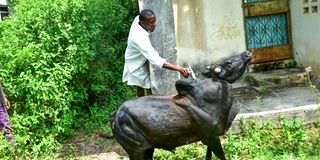Vet on call: Do not confuse this cow disease with deadly rabies

A veterinary officer vaccinates a cow against rabies in Mombasa in January. Livestock farmers ought to note that some cows with rabies may also behave as though they are on heat.
What you need to know:
- Rabies transmission is classified into the domestic and the sylvatic or wildlife cycles. The domestic cycle has the dog as the key transmitter to humans and domestic animals.
- Scientifically, it is accepted that the best way of breaking the dog rabies transmission cycle for humans and domestic animals is to routinely vaccinate 70 per cent of the domestic dogs for at least five years.
- Diligent vaccination of all domestic dogs, combined with post-exposure treatment of people bitten by dogs, would eliminate rabies deaths in domestic dogs and humans.
- Rabies is a viral disease that affects warm-blooded animals but is most common in the domestic dog.
The World Rabies Day was observed globally on September 28, with TV stations and newspapers spearheading discussion on the disease.
This was a good indication that a combination of stakeholders understands the need to participate in rabies eradication interventions to rid the country the disease.
After the panel discussion on TV, I got two questions on phone from viewers. The first one was whether it is really possible to eradicate the disease if its occurrence swings between domestic and wild animals.
The second was a farmer wondering if her cow could be having rabies.
She said the animal makes noise, sometimes behaving like it is on heat, until the voice becomes hoarse. The episodes recur after every 15 to 20 days.
My response to the first question was in the affirmative. Research shows that wild animals rarely transmit rabies to domestic dogs due to the separation between inhabited areas and areas preserved for wildlife.
Rabies transmission is classified into the domestic and the sylvatic or wildlife cycles. The domestic cycle has the dog as the key transmitter to humans and domestic animals.
In the sylvatic cycle, wild animals mainly of the dog family and bats are the main actors. There is only a low level of interaction between the domestic and sylvatic rabies cycles.
Scientifically, it is accepted that the best way of breaking the dog rabies transmission cycle for humans and domestic animals is to routinely vaccinate 70 per cent of the domestic dogs for at least five years.
Diligent vaccination
The vaccination should continue even after rabies appears to have been controlled to prevent re-emergence of the disease.
Diligent vaccination of all domestic dogs, combined with post-exposure treatment of people bitten by dogs, would eliminate rabies deaths in domestic dogs and humans.
Regarding the strangely behaving cow, my answer was negative for rabies. It is true some cows with rabies may behave like though they are on heat.
However, the progression of the disease episode is very different from the case history I was given. Rabid cows with the aggressive form of rabies will be hyperactive, attempt to break out of the pen and foam at the mouth.
Their voices become hoarse and finally mute. This is followed by paralysis of the muscles and the animal finally goes down, never to stand again.
They then become depressed and die. Once the signs of infections show, animals are known to progress to death in contrast with the reported one that has periodic episodes.
I, therefore, diagnosed a reproductive problem known as cystic ovarian disease or cystic ovaries. This is a condition where the cow develops multiple eggs that fail to mature and rupture but they produce high levels of the heat hormone oestrogen.
The hormone causes the animal to get excessive reproductive heat. This results in the hyperactive behaviour. Hoarseness of the voice is due to repeated and prolonged mooing.
The incomplete heat cycles repeat in 15 to 21 days unless the animal is treated. Such animals tend to have excess weight, male-like muscles and never get ready to be inseminated. I advised the farmer to seek help from her nearest animal health service provider.
Eliminate human deaths
The World Rabies Day has been observed globally every year for the last 14 years. Its aim is to create awareness to the public on the disease and remind governments and other stakeholders to enhance their efforts towards rabies eradication.
Rabies is a viral disease that affects warm-blooded animals but is most common in the domestic dog. The close association of dogs with other domestic animals and humans makes it easy for infected dogs to spread the disease.
The World Health Organisation (WHO) and the World Organisation for Animal Health (OIE) require all governments to develop and implement rabies eradication strategies as a collaborative effort of the government agencies in-charge of human and animal health.
Other government and non-governmental actors should be included in the development and implementation of the strategies.
Kenya hopes to eliminate human deaths from rabies by 2030. It is implementing a 15-year step-wise strategy based on the three pillars: (a) Mass dog vaccination, (b) Public awareness and provision of post-exposure treatment to people with dog bites and (c) Improved surveillance for rabies in dogs and humans; with prompt responses to rabies outbreaks.
All dogs, cats, horse and donkey owners should ensure their animals are vaccinated against rabies every year to help in the realisation of a Kenya without human rabies deaths.





